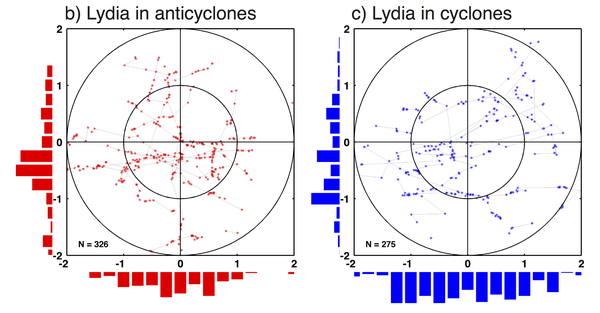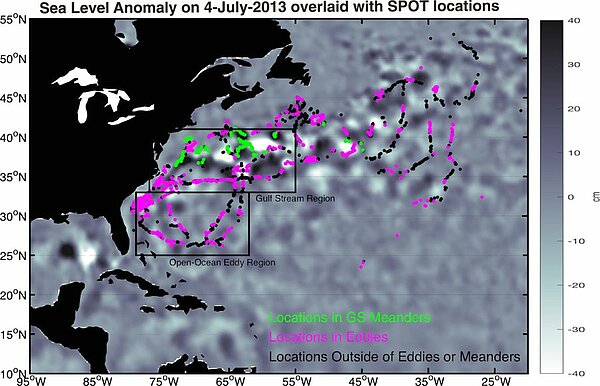Sharks in eddies and meanders
Image of the Month - February 2019

The open ocean is sometimes thought of as "desert". This, however, is not completely true as we observe high variability in phytoplankton biomass associated with eddies and fronts, and there are also a number of species living in these pelagic, or open ocean ecosystems. These pelagic species include including top predators like sharks, tunas, and billfish. In order to develop food web models for open ocean ecosystem to inform fisheries management, understanding how pelagic ecosystems interact with, and are structure by, mesoscale eddies and meanders is a fundamental step. To this end, integrating observations of animal behavior with physical oceanography data showing mesoscale feature (i.e., altimetry data) is one avenue towards building a greater understand of this vast ecosystem.
In a recent study by oceanographers at the Applied Physics Laboratory (University of Washington) and the Woods Hole Oceanographic Institution, the movement of two mature great white sharks were combined with the mesoscale oceanographic variability in the Gulf Stream region and Sargasso Sea. The white sharks were tracked using Argos satellite position tags attached to their dorsal fins. Since this species often swims at the surface, presumably to warm up, their position can be recorded using satellite telemetry tags. These position estimates of sufficient accuracy determine how the sharks use mesoscale ocean feature. In addition, one of the sharks was equipped with an archival tag that records high-resolution time series of temperature and depth. By combining the position and depth data, the authors were able to reconstruct the three-dimensional movement of the sharks.
Results show that the two study animals were more likely to be in anticyclonic eddies (even though in the North Atlantic these are not generally considered to be nutrient-rich). In these anticyclones, the sharks were observed to make regular dives to between 200 m-1000 m (called the ocean "twilight zone" or "mesopelagic region") around the time of sunrise and sunset. The sharks were also more likely to be found in the cores compared to the periphery of anticyclones (no preference in cyclones). The warmer temperature of the anticyclonic is generally warmer than outside of the eddies and may better suit the shark, requiring less energy to regulate their body temperature.
Using the physical parameters of the environment, coupled with animal tracking, scientist are able to better understand, and thus better protect, marine life from the smaller organisms to the top predators.
See also:
- Data: Global mesoscale eddy trajectory atlas
- Applications: Mesoscale circulation
- Applications: Biology
Other web sites on this topic:
- The (Sub)mesoscale Group at Applied Physics Laboratory
- Argos satellite tracking system
- OCEARCH
References:
- Peter Gaube, Camrin D. Braun, Gareth L. Lawson, Dennis J. McGillicuddy Jr, Alice Della Penna, Gregory B. Skomal, Chris Fischer & Simon R. Thorrold, 2018: Mesoscale eddies influence the movements of mature female white sharks in the Gulf Stream and Sargasso Sea, doi.org/10.1038/s41598-018-25565-8





